
1
© Copyright 2003, DB Industries, Inc.
User Instruction Manual
Leading Edge Tripod Anchor
This manual is provided as the Manufacturer’s
Instructions, and should be used as part of an employee
training program as required by OSHA.
DESCRIPTION
Leading Edge Tripod Anchor: Leading Edge Tripod Anchor:
Includes tripod base, swivel head, ratchet buckle, and web assembly.
The swivel head is designed for installation of a DBI/SALA Ultra-Lok®
model self retracting lifeline (SRL). The tripod base allows installation
to a precast concrete anchorage, such as a lifting eye. See Figure 1.
WARNING: This product is part of a personal fall arrest system
(PFAS). The users must read and follow the manufacturer’s
instructions for each component of the system. These instructions
must be provided to the users of this equipment. The users must
read and understand these instructions or have them explained to
them before using this equipment. Manufacturer’s instructions must
be followed for proper use, care and maintenance of this product.
Alterations or misuse of this product or failure to follow instructions,
may result in serious injury or death.
IMPORTANT: If you have questions on the use, care, or suitability
for use of this equipment, contact DBI/SALA immediately. This
instruction manual is intended to be used in conjunction with the
instruction manuals supplied with each system component mentioned
below if applicable. If an instruction was not supplied with the
purchase of that component, contact DBI/SALA immediately.
1.0 APPLICATION
1.1 PURPOSE: The DBI/SALA leading edge tripod anchor is designed to be used as a temporarily installed anchorage
connector on concrete structures. This anchorage connector may be used as part of a personal fall arrest system
(PFAS). This tripod anchor is designed for use with the DBI/SALA Ultra-Lok
®
SRL (specifically model 3504500 or model
series 3504430 and 3504450), DBI/SALA Sayfline Synthetic HLL System (models 7600502 to 7600510) and Wire
Rope Sayfline (models 7602030 through 7602100). Do not hang, lift or support tools or equipment from these tripod
anchors or attach guy lines for antennas, phone lines, etc.
1.2 LIMITATIONS: The following application limitations must be recognized and considered before using this product
(also reference the manufacturer’s instruction supplied with each system component):
A. STRUCTURE: This anchorage connector is intended to be installed on concrete structures. The structure must
be capable of meeting the anchorage strength requirements as set forth in section 2.4. Consult DBI/SALA
before using this tripod anchor on any other applications.
B. CAPACITY: This anchorage connector is designed for use by persons with a combined weight (person,
clothing, tools, etc.) of no more than 310 lbs. Only one personal fall arrest system (PFAS) may be connected
to the anchorage connector at a time.
C. PERSONAL FALL ARREST SYSTEM: This swiveling tripod anchor is designed to be used in conjunction
with the DBI/SALA Ultra-Lok® SRL model 3504500 and may also be used with 3504430 and 3504450. Other
Figure 1 - Swiveling Roof Anchor
Web
Guide
Rachet
Buckle
Attachment Hook
with Web Assembly
Tripod Base
Web
Strap
Roller
Swivel Head

2
PFAS's used with this tripod anchor must meet applicable OSHA, state, federal and ANSI requirements.
PFAS's incorporating a full body harness must be capable of arresting a worker’s fall with a maximum
arresting force of no greater than 1,800 lbs. (900 lbs. maximum arresting force where used with a Sayfline
Horizontal Lifeline System) and limit the free fall distance to 6 ft. or less. The deceleration distance for a
PFAS must be 42 inches (1.1 m) or less. Reference ANSI Z359.1, ANSI A10.14 and OSHA requirements.
D. LOCKING SPEED OF SRL: Situations which do not allow for an unobstructed fall path should be avoided.
Working in very confined or cramped spaces may not allow the body to reach sufficient speed to cause the
SRL to lock should a fall occur. Working on slowly shifting material such as loose shingles may not allow
enough speed build-up to cause the SRL to lock. A similar situation may occur on low pitched roofs where a
worker may slide instead of fall. A clear path is needed to assure positive locking of the SRL.
E. CORROSION: Use near sea water or other corrosive environments may require more frequent inspections
or servicing (replacement) to assure corrosion damage is not affecting the performance of the product.
F. CHEMICAL HAZARDS: Solutions containing acids, alkali, or other caustic chemicals, especially at elevated
temperatures may cause damage to this equipment. Consult DBI/SALA if doubts exists concerning installing
this equipment where chemical hazards are present.
G. ELECTRICAL HAZARDS: Do not install the tripod anchor where it or the user may come into contact with
electrical power lines.
H. TRAINING: This equipment must be installed and used by persons who have been properly trained in its
correct application and use. Installation and use of this equipment must be supervised by a qualified person,
as defined by OSHA fall protection standards.
I. SHARP EDGES: Avoid working where the lifeline will be in contact with or abrade against unprotected sharp
edges.
1.3 Refer to national consensus (including ANSI Z359.1 and ANSI A10.14), applicable local, state, and federal
(OSHA) requirements governing this equipment for more information on anchorage connectors, and associated
system components.
2.0 SYSTEM REQUIREMENTS
2.1 COMPATIBILITY OF COMPONENTS: DBI/SALA equipment is designed for use with DBI/SALA approved
components and subsystems only. Substitutions or replacements made with non-approved components or
subsystems may jeopardize compatibility of equipment and may affect the safety and reliability of the complete
system.
2.2 COMPATIBILITY OF CONNECTORS: Connectors are considered to be compatible with connecting elements
when they have been designed to work together in such a way that their sizes and shapes do not cause their
gate mechanisms to inadvertently open regardless of how they become oriented. Contact DBI/SALA if you have
any questions about compatibility.
Connectors (hooks, carabiners, and D-rings) must be capable of supporting at least 5,000 lbs. (22 kN). Connectors
must be compatible with the anchorage or other system components. Do not use equipment that is not compatible.
Non-compatible connectors may unintentionally disengage. See Figure 2. Connectors must be compatible in size,
shape, and strength. Self locking snap hooks and carabiners are required by ANSI Z359.1 and OSHA.
2.3 MAKING CONNECTIONS: Only use self-locking snap hooks and carabiners with this equipment. Only use
connectors that are suitable to each application. Ensure all connections are compatible in size, shape and
strength. Do not use equipment that is not compatible. Ensure all connectors are fully closed and locked.
DBI/SALA connectors (snap hooks and carabiners) are designed to be used only as specified in each product’s user’s
instructions. See Figure 3 for inappropriate connections. DBI/SALA snap hooks and carabiners should not be connected:
A. To a D-ring to which another connector is attached.
B. In a manner that would result in a load on the gate.

3
NOTE: Large throat opening snap hooks
should not be connected to standard size
D-rings or similar objects which will result
in a load on the gate if the hook or D-ring
twists or rotates. Large throat snap hooks
are designed for use on fixed structural
elements such as rebar or cross members
that are not shaped in a way that can
capture the gate of the hook.
C. In a false engagement, where
features that protrude from the
snap hook or carabiner catch on
the anchor and without visual
confirmation seems to be fully
engaged to the anchor point.
D. To each other.
E. Directly to webbing or rope lanyard or tie-back (unless the manufacturer’s instructions for both the lanyard and
connector specifically allows such a connection).
F. To any object which is shaped or dimensioned such that the snap hook or carabiner will not close and lock, or
that roll-out could occur.
2.4 ANCHORAGE STRENGTH: The anchorage to which the tripod
anchor is installed must meet minimum strength(s) as given below
for the applications selected:
FALL ARREST: The loads applied to the tripod anchor from
personal fall arrest systems are magnified by the design of the
tripod anchor, therefore the ANSI Z359.1 required minimums are
not appropriate. The leading edge tripod requires anchorages that
are able to support 10,000 lbs in a vertical direction and 5,000 lbs
horizontally for fall arrest applications.See Figure 4.
If the connecting element that a snap hook (shown) or carabiner attaches to is undersized or irregular in shape,
a situation could occur where the connecting element applies a force to the gate of the snap hook or carabiner.
This force may cause the gate (of either a self-locking or a non-locking snap hook) to open, allowing the snap
hook or carabiner to disengage from the connecting point.
1. Force is applied to the
snap hook.
2. The gate presses against
the connecting ring.
3. The gate opens allowing the
snap hook to slip off.
Figure 2 - Unintentional Disengagement (Roll-out)
Small ring or other
non-compatibly
shaped element
Figure 3 - Inappropriate Connections
Figure 4 - Anchorage Strength
10,000 lbs. Fall Arrest
6,000 lbs. Restraint
5,000 lbs. Fall Arrest
3,000 lbs. Restraint

4
UNEXPECTED HAZARDS
SWING FALL HAZARD
RESTRAINT: The loads applied to the tripod anchor from personal fall arrest systems are magnified by the design
of the tripod anchor, therefore the ANSI Z359.1 required minimums are not appropriate. The leading edge tripod
requires anchorages that are able to support 6,000 lbs for restraint applications. See Figure 4.
Anchorages used for attachment of personal fall arrest systems (PFAS) shall be independent of any anchorage
being used to support or suspend platforms.
3.0 OPERATION AND USAGE
WARNING: Do not alter or intentionally misuse this equipment. Consult with DBI/SALA if using this equipment in
combination with components or subsystems other than those described in this manual. Some subsystems and
components combinations may interfere with the proper operation of this equipment.
WARNING: Consult your doctor if there is reason to doubt your fitness to safely absorb the shock from a fall arrest. Age and
fitness seriously affect a worker's ability to withstand falls. Pregnant women and minors must not use this equipment.
3.1 BEFORE EACH USE of this equipment, carefully inspect it to assure that it is in serviceable condition. Check for
worn or damaged parts. Ensure the tripod anchor is secure and not distorted. Inspect for sharp edges, burrs,
cracks, or corrosion. Inspect the web assembly: ensure the hook is not distorted or has any sharp edges, burrs,
cracks, or corrosion; inspect the webbing for wear, cuts, burns, frayed edges, breaks, or other damage. Inspect
other fall arrest equipment in accordance with the manufacturer's instructions supplied with each system
component. Refer to section 5.0 for further inspection details. Do not use if inspection reveals an unsafe condition.
3.2 PLAN your fall arrest system before starting your work. Take into consideration factors affecting your safety at
any time during use. The following list gives some important points you must consider when planning your system:
A. ANCHORAGE: Select an anchorage point that is rigid and capable of supporting the required loads. See
section 2.4. Locate the tripod anchor in accordance with section 3.3.
B. OTHER CONSIDERATIONS: Personal fall arrest systems must be rigged to limit any free fall to a maximum
of 6 feet (OSHA and ANSI Z359.1) or 5 feet (ANSI A10.14). Avoid working above your anchorage level since
an increased free fall distance will result. Avoid working
where your line may cross or tangle with that of another
worker or another object. Do not allow the lifeline to pass
under arms or between legs. Never clamp, knot or
otherwise prevent the lifeline from retracting or being taut,
avoid slack line. Do not lengthen the SRL by connecting
a lanyard or similar component without consulting
DBI/SALA.
C. TOTAL FALL DISTANCE: Should a fall occur, there must
be sufficient clearance in the fall area to arrest the fall
before striking the ground or other object. The total fall
distance is the distance measured from the onset of a fall
to the point where the fall is arrested. A number of factors
can influence the total fall distance including; user's
weight, anchorage location relative to the fall (swing fall),
body support with sliding D-ring, and the type of fall arrest
equipment you attach to the tripod anchor. For specific
clearance requirements read and follow the manufacturer’s
instructions for your subsystem fall arrest equipment.
D. SWING FALLS: See Figure 5. Swing falls occur when the
anchorage point is not directly above the point where a fall
occurs. The force of striking an object while swinging
(horizontal speed of the user due to the pendulum affect)
can be great and may cause serious injury. Swing falls can
be minimized by working as directly below the anchorage
point as possible. In a swing fall situation, the total vertical
fall distance of the user will be greater than if the user had
Figure 5 - Swing Fall

5
8 FT
6 FT
6 FT
SHARP
EDGE
FULL BODY
HARNESS
TRIPOD
ANCHOR
IN-LINE SHOCK
ABSORBER
PN 1220362
SRL
fallen vertically directly below the anchorage point. The user must therefore account for an increase in the
total free fall distance and the area needed to safely arrest the fall.
The SRL will activate (lock-up) regardless of it's orientation and location relative to the user's position. Do not
captivate the lifeline of an SRL, it may affect the performance of its braking. If a swing fall hazard exists in
your application, contact DBI/SALA before proceeding.
E. SHARP EDGES: Avoid working where the connecting
subsystem (i.e. SRL, full body harness, lanyard, lifeline,
etc.) or other system components will be in contact with, or
abrade against unprotected sharp edges. See Figure 6. If
working with this equipment near sharp edges is
unavoidable, protection against cutting must be provided
by using a heavy pad or other means over the exposed
sharp edge. If you are not using the Leading Edge SRL
(PN 3504500), it is recommended that an energy absorber
(PN 1220362) be installed in-line between the harness and
the self retracting lifeline to further protect the worker.
Compatibility and total fall distance issues must be
considered if this is done. Contact DBI/SALA before using in-line energy absorbing components or lanyards
with self retracting lifelines.
F. RESCUE: Should a fall occur, the user (employer) must have a rescue plan and the means at hand to implement it.
G. AFTER A FALL: Any equipment which has been subjected to the forces of arresting a fall must be removed
from service immediately and destroyed or contact a factory authorized service center for repair.
3.3 INSTALLATION REQUIREMENTS:
TRIPOD ANCHOR SITE PLAN: Before starting
the roof construction, a plan should be
established as to where the tripod anchor(s) will
be installed and when, during the construction
process, they may be used. See Figure 7.
The following are guide lines on locating
tripod anchors:
• The tripod anchor is for use in an upright
position on a horizontal surface only.
• The tripod anchor should be located at least 6 ft. away from any leading edge. On very small roof areas,
locate the tripod anchor as far from the leading edge as possible.
• Do not leave the tripod anchor permanently installed. The tripod anchor is designed for temporary use only.
3.4 TRIPOD ANCHOR INSTALLATION: Tripod anchors must be installed in accordance with the previously discussed
site plan. Site work rules must be followed regarding when an installed tripod anchor is ready for use (i.e. properly
braced, etc.).
Position the Tripod anchor over an anchorage capable of withstanding the
loads given in section 2.4.
Ensure the shackle attached to the ratchet buckle is positioned over the lug,
and the pin is in place. See Figure 8.
The ratchet strap must pass through the black plastic web guide built into the
tripod and over the roller as the strap exits the top member of the tripod. See
Figure 1. The strap must also pass through the center of the ratchet buckle
hub. To release the ratchet strap, pull the lever on the ratchet handle and
move the ratchet buckle handle to the “full up” position. See Figure 9.
Figure 6 - Sharp Edges
Figure 7 - Roof Anchor Site Plan
SHACKLE
(HLL
CONNECTION)
PIN
LUG
Figure 8 - Secured Rachet Buckle

6
FULL DOWN
POSITION
(LOCKED)
FULL UP
POSITION
(RELEASED)
PULL
LEVER
WEB STRAP
CENTER HUB
Pull out as much of the strap as necessary to connect the hook to the
anchorage. Ensure the latch on the hook fully closes over the anchorage.
Do not use on anchorages that load only the tip of the hook or side load
the hook. Do not use on anchorages that prevent the hook latch from
closing. The tripod must straddle the anchor,i.e., the anchor must be
inside the tripod legs. See Figure 10. The diameter of the anchorage cross
section must be less than 1 inch.
To remove slack in the ratchet strap, pull the lever on the ratchet handle
and rotate the handle downward. After the handle is out of the locked
position, release the lever and continue to rotate the handle down. The
ratchet mechanism will allow the handle to take up more slack with each
upward rotation. Continue the ratchet movement until the strap is taut.
Lock the ratchet strap by returning to the ratchet buckle handle to the full
down position before use. Figure 9 shows the ratchet buckle in the full
down working position. Ensure the ratchet buckle remains in the full down
working position during use.
A. INSTALLING THE SRL: The SRL mounts to the swiveling tripod
anchor with two 3/8 inch bolts and nylon insert nuts. See Figure 11.
Use the SRL according to the manufacturer’s instructions included
with the SRL.
B. REMOVAL OF THE TRIPOD ANCHOR: The tripod anchor is a
temporary anchor. To remove it, pull the lever on the ratchet handle
and rotate the handle to the full up position. See Figure 10. When the
lever is released it will snap into a locked position. The center hub will
rotate freely then and the ratchet strap may be pulled out to create
enough slack for the hook to be removed from the anchor.
3.5 BODY SUPPORT: When using the DBI/SALA leading edge tripod anchor,
it is recommended that a full body harness be worn. For general fall
protection use, connect to the D-ring on the back between the shoulders
(dorsal D-ring).
IMPORTANT: Body belts are not allowed for free fall situations. Body belts
increase the risk of injury during fall arrest in comparison to a full body harness.
Limited suspension time and the potential for improperly wearing a body belt
may result in added danger to the user’s health.
3.6 CONNECTING TO THE TRIPOD ANCHOR: Figure 12 illustrates the proper
connection of typical fall arrest equipment to the tripod anchor. Always
protect the lifeline from abrading against sharp or abrasive surfaces on
the roof. Make sure all the connections are compatible in size, shape and
strength. Never connect more than one personal protective system to any
single tripod anchor at a time. The tripod anchor may be used with an
SRL or alternately with an HLL, but may not be used with both simultaneously
SRL: Connection to the installed tripod anchor
is made by attaching the self locking snap
hook at the end of the Ultra-Lok's
®
lifeline to
the back dorsal D-ring (fall arrest attachment
point) of the user's body support (i.e. full body
harness). When connecting, make sure the
connecting hook is fully closed and locked.
Review section 3.2 if using an SRL near sharp
edges.
HORIZONTAL LIFELINE (HLL) SYSTEM: The swiveling tripod anchor can be used as an end anchor for DBI/
SALA Sayfline Synthetic HLL Systems (models 7600502 to 7600510) and Sayfline Wire Rope HLL Systems
Figure 11 - Installing The SRL
Figure 9 - Rachet Operation
Figure 10 - Attaching to Anchor
Figure 12 - Correct Connections
HOOK LATCH
MUST CLOSE
AND LOCK

7
SHACKLE
PIN
LUG
REMOVE PIN
ROTATE SHACKLE
OFF LUG
SLIDE RATCHET BUCKLE
UP ARM AND OUT OF
KEYHOLE SLOT
(7602030 to 7602100). This system utilizes energy absorbers to limit end loads to a maximum of 1800 lbs. or 2500 lbs.
See the manufacturer’s instructions for the HLL System for more information. (Contact DBI/SALA for more
information on Sayfline HLL systems.) If someone is attached to an HLL between two tripods, no one is allowed
to attach to an SRL on either of the tripods supporting that HLL.
Place two Tripod Anchors over anchorages capable of withstanding the loads given in section 2.4 and a maximum of
60 ft. apart. Position each tripod anchor so that the leg with the ratchet buckle faces directly toward the other
tripod anchor. Pull out as much of the strap as necessary to connect the hook to the anchorage. Connect the hook
on the end of the ratchet strap to the anchorage. Ensure the latch on the hook fully closes over the anchorage.
Do not use the tripod anchor on anchorages that load only the tip of the hook or that side load the hook. Do not
use on anchorages that prevent the latch from closing. The diameter of the anchorage cross section must be less
than 1 inch.
The ratchet buckle is
used as the tensioning
device for the Horizontal
lifeline (HLL). Remove
the ratchet buckle from
the tripod leg by first
removing the pin holding
the shackle. Then, rotate
the shackle until it clears
the lug. Next, slide the
ratchet buckle up the leg
and pull the ratchet
buckle out of the keyhole
slot. See Figure 13. To
replace the ratchet
buckle, reverse this
procedure. Ensure the
shackle attached to the ratchet buckle is positioned over the lug, and the pin is in place.
Connect the HLL system to the shackle attached to the ratchet buckle following the manufacturer’s instructions
supplied with the HLL. When the HLL is secured to each of the tripod anchors, tension the HLL by operating one or
both of the ratchets. See Figure 14. Tighten the HLL until the line has the appropriate amount of sag as described
in the HLL User’s Manual. The ratchet buckle handle must be rotated to the full down position while the HLL is in
use. Refer to Figure 9.
Connect to the HLL and use it following the manufacturer’s instructions provided with the HLL. This HLL
installation is not a permanent installation. When the HLL is no longer needed, it must be removed.
3.7 FALL CLEARANCE: The Tripod Anchor HLL installation requires greater fall clearance than most other HLL
installations. DBI/SALA recommends that the Tripod Anchor HLL be used in restraint applications only because of
the greater clearance required. See Tables 1 and 2 for clearance requirements for shock absorbing lanyard
applications. See Tables 3 and 4 for clearance requirements for Self Retracting Lifeline (SRL) applications.
Figure 13 - Rachet Buckle Attachment
Figure 14 - Rachet Buckle Attachment
WEB STRAP
RATCHET BRACKET
SHACKLE
O-RING
HORIZONTAL LIFELINE
ANCHOR

8
Span Length
Required
Clearance
Lower Level
or Obstruction
Working
Level
Energy
Absorbing
Lanyard
Span Length
Required
Clearance
Lower Level
or Obstruction
Working
Level
Energy
Absorbing
Lanyard
IMPORTANT: Clearance values are given from the working
level to the next lower level or obstruction, assuming a 6 ft.
free fall. If the Leading Edge Tripod Anchor HLL is located at
the leading edge, the maximum energy absorbing lanyard
length is 4 ft. Longer lanyards may be used if the Tripod
Anchor HLL is located some distance from the leading edge,
but the system must be rigged to limit any free fall to a
maximum of 6 ft.
IMPORTANT: Clearance values are given from the working
level to the next lower level or obstruction, assuming a 6 ft.
free fall. DBI/SALA reccommends that an energy absorber
(PN 1220362) be installed in-line between the harness and
the self retracting lifeline to further protect the worker.
ALAS/IBDotdetcennoCsrekroWowTroenOrofecnaraelCderiuqeR
htiw)0150067ot5050067sledoM(metsySLLHcitehtnySenilfyaS
senilefiLgnitcarteRfleSALAS/IBD
)teefni(htgneLnapS ecnaraelCderiuqeR
01ot0.ni5.tf61
51-01.ni8.tf71
02-51.ni01.tf81
52-02.ni11.tf91
03-52ni11.tf02
53-03.ni0.tf22
04-53.ni11.tf22
54-04.ni8.tf42
05-54.ni3.tf62
55-05.ni0.tf82
06-55.ni7.tf92
ALAS/IBDotdetcennoCsrekroWowTroenOrofecnaraelCderiuqeR
htiw)0150067ot5050067sledoM(metsySLLHcitehtnySenilfyaS
sdraynaLgnibrosbAygrenEALAS/IBD
)teefni(htgneLnapS ecnaraelCderiuqeR
01ot0.ni11.tf61
51-01.ni6.tf81
02-51.ni0.tf02
52-02.ni5.tf12
03-52ni9.tf22
53-03.ni5.tf42
04-53.ni11.tf52
54-04.ni4.tf72
05-54.ni8.tf82
55-05.ni1.tf03
06-55.ni6.tf13
ALAS/IBDotdetcennoCsrekroWowTroenOrofecnaraelCderiuqeR
ALAS/IBDhtiw)0012067ot0302067sledoM(metsySepoReriWenilfyaS
sdraynaLgnibrosbAygrenE
)teefni(htgneLnapS ecnaraelCderiuqeR
01ot0.ni5.tf51
51-01.ni8.tf61
02-51.ni9.tf71
52-02.ni0.tf91
03-52ni11.tf91
53-03.ni0.tf12
04-53.ni0.tf22
54-04.ni0.tf32
05-54.ni01.tf32
55-05.ni11.tf42
06-55.ni01.tf52
TABLE 2
TABLE 1
TABLE 3
TABLE 4
ALAS/IBDotdetcennoCsrekroWowTroenOrofecnaraelCderiuqeR
htiw)0012067ot0302067sledoM(metsySLLHepoReriWenilfyaS
senilefiLgnitcarteRfleSALAS/IBD
)teefni(htgneLnapS ecnaraelCderiuqeR
01ot0.ni5.tf41
51-01.ni6.tf51
02-51.ni7.tf61
52-02.ni7.tf71
03-52ni6.tf81
53-03.ni5.tf91
04-53.ni4.tf02
54-04.ni3.tf12
05-54.ni1.tf22
55-05.ni11.tf22
06-55.ni9.tf32

9
3.8 NORMAL OPERATION: Once attached, the worker is free to move about within the recommended working areas.
SRL: Should a fall occur, a speed sensing brake system will activate, stopping the fall and absorbing much of the
energy created. Sudden or quick movements should be avoided during the normal work operation since this may
cause the SRL to lock-up.
NOTE: This series of SRL's incorporates a brake system with a cam rocker brake engagement that creates
an audible indicator (clicking sound) which informs the user that the brake pawl system is working
properly. For further information on the Ultra-Lok
®
SRL, refer to the manufacturer’s instruction manual.
WARNING: Read and follow the manufacturer's instructions for associated equipment (i.e. SRL, full body harness,
lanyard, lifeline, etc.) used in your personal fall arrest system.
IMPORTANT: For special (Custom) versions of this product, follow the instructions herein. If enclosed, see attached
supplement for additional instructions to be followed when using a customized product.
4.0 TRAINING
4.1 It is the responsibility of all users of this equipment to understand these instructions, and to be trained in the
correct installation, use, and maintenance of this equipment. These individuals must be aware of the
consequences of improper installation or use of this equipment. This user manual is not a substitute for a
comprehensive training program. Training must be provided on a periodic basis to ensure proficiency of the users.
IMPORTANT: Training must be conducted without exposing the trainee to a fall hazard. Training should be repeated
periodically.
5.0 INSPECTION
5.1 FREQUENCY: Before each use visually inspect the tripod anchor per the steps listed in section 5.2 and 5.3
IMPORTANT: If this equipment has been subjected to forces resulting from the arrest of a fall, it must be immediately
removed from service and destroyed or returned to DBI/SALA for possible repair. See section 5.2.
5.2 INSPECTION POINTS: (refer to manufacturer’s instruction supplied with each system component for inspection
procedures)
• Inspect the tripod anchor for physical damage. Look carefully for any signs of cracks, dents or deformities
in the metal.
• Inspect the tripod anchor for signs of excessive corrosion. Make certain the anchor swivels 360° properly
and if applicable that the Ultra-Lok® SRL is attached to the anchor correctly.
• Inspect each system component or subsystem (i.e. SRL, full body harness, lanyard, lifeline, etc.) per
associated manufacturer’s instructions.
• The webbing material must be free of frayed, cut, or broken fibers. Check for tears, abrasions, mold, burns,
or discoloration, etc. The webbing must be free of knots, excessive soiling, heavy paint buildup, and rust
staining. Check for chemical or heat damage indicated by brown, discolored, or brittle areas. Check for
ultraviolet damage indicated by discoloration and the presence of splinters or slivers on the webbing surface.
All of the above factors are known to reduce webbing strength. Damaged or questionable webbing should be
replaced. Inspect stitching for pulled or cut stitches.
• Inspect the web guide for deformation or cracks. The web guide prevents the web from abrading against
the steel tubing.
• Inspect the hook for distortion, sharp edges, burrs, cracks, worn parts or corrosion. Ensure the hook
works properly. The hook gate must move freely and lock upon closing.
• Record the inspection date and results in the inspection log. See section 9.0.

10
I D Label PN9504137
Inspection Label PN 9500391
Warning Label PN 9504317
5.3 If inspection reveals a defective condition, remove the unit from service immediately and destroy, or contact a
factory authorized service center for repair.
IMPORTANT: Only DBI/SALA or parties authorized in writing may make repairs to this equipment.
6.0 MAINTENANCE - SERVICING - STORAGE
6.1 Clean the swivelling tripod anchor with a mild soap detergent solution. Excessive build-up of dirt, tar, etc. may
prevent the anchor from working properly. A small amount of oil or grease can be applied to the anchor to help the
swiveling action. If you have any questions concerning the condition of your tripod anchor, or have any doubt
about putting it into service, contact DBI/SALA immediately. Refer to the manufacturer’s instructions supplied with
each system component for maintenance, servicing, and storage procedures.
6.2 Additional maintenance and servicing procedures (i.e. replacement parts) must be completed by a factory
authorized service center. Authorization must be in writing.
7.0 SPECIFICATIONS
7.1 COMPONENTS:
MATERIALS:
Tripod base: Carbon steel
Swivel Head: Carbon steel
Webbing: Polyester
Ratchet web hook: Forged steel
FINISH: Black E-coat paint and zinc-plating
WEIGHT: 33 lbs. (without SRL)
SIZE: 26 in. x 26 in. x 24 in.
CAPACITY: 310 lbs. (one person)
MINIMUM BREAKING STRENGTH: 5,000 lbs.
8.0 LABELING
8.1 These labels should be securely attached to the tripod anchor
and fully legible. See applicable manufacturer’s instructions for
subsystem components labels.

ETADNOITCEPSNISMETINOITCEPSNI
DETON
NOITCAEVITCERROCECNANETNIAM
DEMROFREP
:yBdevorppA
:yBdevorppA
:yBdevorppA
:yBdevorppA
:yBdevorppA
:yBdevorppA
:yBdevorppA
:yBdevorppA
:yBdevorppA
:yBdevorppA
:yBdevorppA
:yBdevorppA
9.0 INSPECTION AND MAINTENANCE LOG
DATE OF MANUFACTURE: _______________________________________________________________________
MODEL NUMBER: ______________________________________________________________________________
DATE PURCHASED: ____________________________________________________________________________
11

12
USA Canada
3965 Pepin Avenue 260 Export Boulevard
Red Wing, MN 55066-1837 Mississauga, Ontario L5S 1Y9
Toll Free: 800-328-6146 Toll Free: 800-387-7484
Phone: (651) 388-8282 Phone: (905) 795-9333
Fax: (651) 388-5065 Fax: (905) 795-8777
www.salagroup.com www.salagroup.com
This manual is available for download at www.salagroup.com.
Form: 5902215
Rev: A
I S O
9 0 0 1
Certificate No. FM 39709
-
 1
1
-
 2
2
-
 3
3
-
 4
4
-
 5
5
-
 6
6
-
 7
7
-
 8
8
-
 9
9
-
 10
10
-
 11
11
-
 12
12
3M DBI-SALA® Concrete Leading Edge Tripod Anchor 2105500, 1 EA User manual
- Type
- User manual
- This manual is also suitable for
Ask a question and I''ll find the answer in the document
Finding information in a document is now easier with AI
Related papers
-
3M DBI-SALA® Saflok Max™ Web Anchor 1231305, 1 EA Operating instructions
-
3M DBI-SALA® 3-Man Swiveling Roof Anchor 2103690, 1 EA Operating instructions
-
3M PROTECTA® PRO-Line™ Temporary Horizontal Lifeline System 1200101, EA Operating instructions
-
3M PROTECTA® PRO™ Pack Shock Absorbing Lanyard Operating instructions
-
3M PROTECTA® PRO™ Pack Pack 420 lbs. Capacity Shock Absorbing Lanyard 1341011, Red, 6 ft. (1.8m), 1 EA/Case Operating instructions
-
3M PROTECTA® PRO™ Concrete Anchor Strap 2190064, 25 EA Operating instructions
-
3M DBI-SALA® Rope Lifeline Operating instructions
-
DBI-SALA DBI-SALA® Cab Mount Self Retracting Lifeline, Web 3101008, 8 ft. (2.4m), 1 EA User manual
-
3M PROTECTA® PRO™ Pack Tie-Back Tie-Off Shock Absorbing Lanyard 1340040, 1 EA Operating instructions
-
3M DBI-SALA® Rope Positioning Lanyard, Nylon 1232354, 1 EA Operating instructions
Other documents
-
Kmart P_42586937 Operating instructions
-
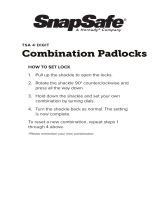 SnapSafe 76020 Installation guide
SnapSafe 76020 Installation guide
-
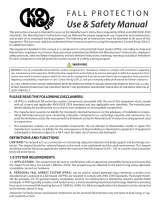 Kong Back-Up Shock Pack User manual
Kong Back-Up Shock Pack User manual
-
Honeywell Miller MightEvac User Instruction Manual
-
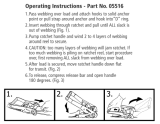 Keeper 05516 Operating instructions
Keeper 05516 Operating instructions
-
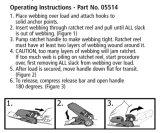 Keeper 05514 Operating instructions
Keeper 05514 Operating instructions
-
Grizzly T10819 Owner's manual
-
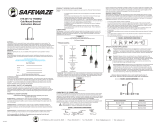 SafeWaze 019-4017 Owner's manual
SafeWaze 019-4017 Owner's manual
-
DBI SALA Sayfline 7603160 User Instruction Manual
-
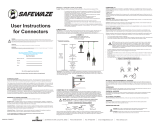 SafeWaze FS1017 Owner's manual
SafeWaze FS1017 Owner's manual

















